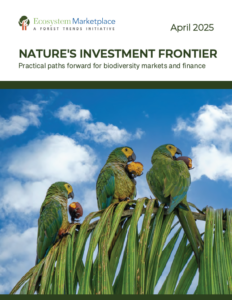Nature’s investment frontier
Practical paths forward for biodiversity markets and finance
By Ricardo Bayon, Charles Bedford, Genevieve Bennett, Adam Davis, Ben Guillon, Katherine Hamilton, Michael Jenkins, Dr. Timothy Male, Martine Maron, Julia McCarthy, Yuejia Peng, Fabien Quétier, Mariana Sarmiento, Ryan Sarsfield, David Tepper, and Amrei von Hase View PublicationBiodiversity-based investment themes are suddenly in the spotlight, after years of feeling like a bit of an understudy to the carbon market. Given a ballooning finance gap for nature, and the obvious materiality of nature risk to business, there is renewed interest in economic instruments that can drive private investment toward interventions to avert biodiversity loss or restore degraded ecosystems, and in doing so generate attractive cash flows.
These economic instruments have been around for decades. The first habitat banks appeared in the United States in the early 1980s. But recent growth in the market for voluntary carbon credits has clearly been a catalyst for renewed interest in whether a similar instrument might be applied to the problem of global nature loss. It’s been buoyed by a surge in venture capital funding for NatureTech startups, a sizeable number of whom are focused on measurement, reporting, and verification (MRV) and biodiversity credits.
This report offers a diverse set perspectives from experts in biodiversity and nature finance on what the forward path looks like to drive more private investment into nature and biodiversity. It begins with a look back on what we’ve learned about delinking development from nature loss from three decades of experience and experimentation with biodiversity markets, with an essay contributed by Adam Davis, Co-founder and Managing Partner at Ecosystem Investment Partners (“Offsets and investments: Thoughts on de-linking economic development and biodiversity loss”).
There are sizeable opportunities, connected to a wave of new infrastructure investment on the horizon globally to expand that model to new geographies, as Mariana Sarmiento, Charles Bedford, and Dr Timothy Male argue (“How we harness an infrastructure boom to close the biodiversity finance gap,”). Doing so would chart a different course for economic development in Global South countries where nature is substantially still intact. Nature-based asset classes are a promising field for entrepreneurs and land managers. But a reality check is due on what is likely to really attract demand, Ben Guillon and Genevieve Bennett argue (“Design for demand: What actually drives private finance for nature?”).
On the demand side, biodiversity credits and other conservation assets offer a path to not simply fix the damage, but go “nature positive” by creating more nature than there was before. These ambitions need to be grounded in the mitigation hierarchy, or credits could be used for greenwashing, warn Martine Maron, Fabien Quétier, and Amrei von Hase (“No shortcuts to nature positive”). Biodiversity might lend itself well to being “stacked” with or “stapled on” to other investments in carbon and value chains. Julia McCarthy and Ryan Sarsfield (“Beetles in a pay stack”) offer a useful framework for thinking about how to do this effectively.

